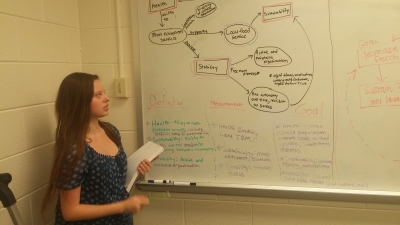We teach students factual knowledge and expect them to assimilate critical thinking and synthesis, but this has always seemed odd to me; even presenting knowledge in a certain order, discussing assumptions, and pointing out flaws does not replicate the process of discovery and analysis that goes on when one is problem solving. I want my students to be, first and foremost, good problem solvers. Most of them will not be ecologists, but all of them will need to solve problems. Accordingly, I’ve flipped the emphasis in all my classes to stress problem understanding and analysis, and allow content to be assimilated as part of this process. This takes the students some time to adjust, and in my Honors Ecology course, a critical juncture occurs in roughly the middle of class, when the students are asked to consider the “problem” of Lake Victoria. This lake, which is bordered by several African nations, is a canonical example of a human caused ecological disaster. In an evil cycle, the Nile perch was introduced to this lake to provide a commercial fishery, but this invader disrupted the preexisting ecosystem, driving native species to extinction or near extinction, resulting in a degraded habitat that could no longer support the fishery. Forced into over exploitation, and abetted by other human impacts, the fishery has crashed and environmental quality has declined drastically, creating conditions of poverty and ill-health in those who formerly lived around the lake. Students are asked to “solve the problem” of Lake Victoria, from the perspective of commercial fisherman, local residents, or a conservation NGO. Students devise a plan from the perspective of one of these stakeholders, and then meet together to develop a consensus.
 Lake Victoria is a classic wicked problem; hard to define a priority, with different groups naturally focusing, at least initially, on a rather limited version of the problem driven by their particular stakeholder identity. The commercial fisherman seek a sustainable fishery, and the NGO wishes to restore the lake. But since the students must come up with an executable plan, they are forced to consider how they must define “success” and how to measure it. As they soon realize, invoking a word does not automatically clarify the nature of the problem. What does “sustainable” mean? How would one decide an ecosystem is restored, especially when it is impossible to recreate species that are no longer present? The students’ definition of the “problem” evolves as they consider it; they realize that a sustainable economy depends on an ecological system that can maintain a certain level and type of functioning over time. They learn that although some parts of the system are gone forever, restoring a system can correspond to creating conditions that allow for similar ecological interactions and functions as before. They realize that the issues surrounding Lake Victoria are the result of complex interactions between two complex sub-systems - the ecological and the human. They realize that the barriers to solutions are sometimes less technical than the result of differing definitions of what the “problem” really is.
Lake Victoria is a classic wicked problem; hard to define a priority, with different groups naturally focusing, at least initially, on a rather limited version of the problem driven by their particular stakeholder identity. The commercial fisherman seek a sustainable fishery, and the NGO wishes to restore the lake. But since the students must come up with an executable plan, they are forced to consider how they must define “success” and how to measure it. As they soon realize, invoking a word does not automatically clarify the nature of the problem. What does “sustainable” mean? How would one decide an ecosystem is restored, especially when it is impossible to recreate species that are no longer present? The students’ definition of the “problem” evolves as they consider it; they realize that a sustainable economy depends on an ecological system that can maintain a certain level and type of functioning over time. They learn that although some parts of the system are gone forever, restoring a system can correspond to creating conditions that allow for similar ecological interactions and functions as before. They realize that the issues surrounding Lake Victoria are the result of complex interactions between two complex sub-systems - the ecological and the human. They realize that the barriers to solutions are sometimes less technical than the result of differing definitions of what the “problem” really is.
The complex and interlocking nature of the interactions surrounding Lake Victoria forces the students to employ the concept map technique. Although I have encouraged them to do this for weeks, it is at this point the students realize the utility. A common observation from the students at this time is how difficult it is to understand complex causal chains, feed-back loops, multi-causality etc., without these sorts of visualizations. Of course, these are all the phenomena that make it hard to sometimes understand problems, and the “aha” moment the students have about this tends to stay with them. Once reluctant to map out these relationships visually, most students begin to use this technique consistently through the rest of the course and state it helps them be much better problem definers and solvers. Along the way, they learn a lot of ecology.